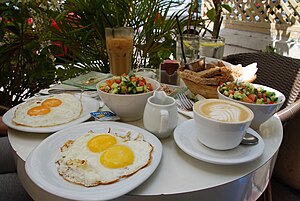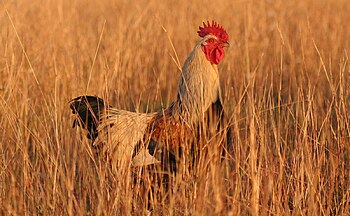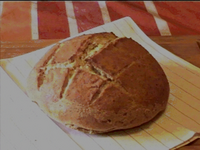Portal:Food
F o o d
A portal dedicated to food and foodways
Introduction


Food is any substance consumed by an organism for nutritional support. Food is usually of plant, animal, or fungal origin and contains essential nutrients such as carbohydrates, fats, proteins, vitamins, or minerals. The substance is ingested by an organism and assimilated by the organism's cells to provide energy, maintain life, or stimulate growth. Different species of animals have different feeding behaviours that satisfy the needs of their metabolisms and have evolved to fill a specific ecological niche within specific geographical contexts.
Omnivorous humans are highly adaptable and have adapted to obtain food in many different ecosystems. Humans generally use cooking to prepare food for consumption. The majority of the food energy required is supplied by the industrial food industry, which produces food through intensive agriculture and distributes it through complex food processing and food distribution systems. This system of conventional agriculture relies heavily on fossil fuels, which means that the food and agricultural systems are one of the major contributors to climate change, accounting for as much as 37% of total greenhouse gas emissions. (Full article...)
Cooking, also known as cookery or professionally as the culinary arts, is the art, science and craft of using heat to make food more palatable, digestible, nutritious, or safe. Cooking techniques and ingredients vary widely, from grilling food over an open fire, to using electric stoves, to baking in various types of ovens, reflecting local conditions. Cooking is an aspect of all human societies and a cultural universal.
Preparing food with heat or fire is an activity unique to humans. Archeological evidence of cooking fires from at least 300,000 years ago exists, but some estimate that humans started cooking up to 2 million years ago.
The expansion of agriculture, commerce, trade, and transportation between civilizations in different regions offered cooks many new ingredients. New inventions and technologies, such as the invention of pottery for holding and boiling of water, expanded cooking techniques. Some modern cooks apply advanced scientific techniques to food preparation to further enhance the flavor of the dish served. (Full article...)

Israeli cuisine primarily comprises dishes brought from the Jewish diaspora, and has more recently been defined by the development of a notable fusion cuisine characterized by the mixing of Jewish cuisine and Arab cuisine. It also blends together the culinary traditions of the various diaspora groups, namely those of Middle Eastern Jews with roots in Southwest Asia and North Africa, Sephardi Jews from Iberia, and Ashkenazi Jews from Central and Eastern Europe.
The country's cuisine also incorporates food and drinks traditionally included in other Middle Eastern cuisines (e.g., Iranian cuisine from Persian Jews and Turkish cuisine from Turkish Jews) as well as in Mediterranean cuisines, such that spices like za'atar and foods such as falafel, hummus, msabbaha, shakshouka, and couscous are now widely popular in Israel. However, the identification of Arab dishes as Israeli has led to accusations of cultural appropriation against Israel by Palestinians and other Arabs. (Full article...)
Selected article –

The history of chocolate in Spain is part of the culinary history of Spain as understood since the 16th century, when the colonisation of the Americas began and the cocoa plant was discovered in regions of Mesoamerica, until the present. After the conquest of the Aztec Empire, cocoa as a commodity travelled by boat from the port of New Spain to the Spanish coast. The first such voyage to Europe occurred at an unknown date in the 1520s. However, it was only in the 17th century that regular trade began from the port of Veracruz, opening a maritime trade route that would supply the new demand from Spain, and later from other European countries.
In contrast to other new culinary ingredients brought from the Americas, the acceptance and growth in popularity of chocolate in Spain was rapid, reaching its peak at the end of the 16th century. Although chocolate was not immediately adopted by other European societies, it eventually made its way to becoming a high commodity. Once the Europeans realised the societal value of chocolate, they started to incorporate it more into their diet. (Full article...)Selected cuisine -
Australian cuisine is the food and cooking practices of Australia and its inhabitants. Australia has absorbed culinary contributions and adaptations from various cultures around the world, including British, European, Asian and Middle Eastern.
Indigenous Australians have occupied Australia for some 65,000 years, during which they developed a unique hunter-gatherer diet, known as bush tucker, drawn from regional Australian plants and animals. Australia became a collection of British colonies from 1788 to 1900, during which time culinary tastes were strongly influenced by British and Irish migrants, with agricultural products such as beef cattle, sheep and wheat becoming staples in the local diet. The Australian gold rushes introduced more varied immigrants and cuisines, mainly Chinese, whilst post-war immigration programs led to a large-scale diversification of local food, mainly due to the influence of migrants from the Mediterranean, East Asia and South Asia. (Full article...)Selected ingredient –

Rice flour (also rice powder) is a form of flour made from finely milled rice. It is distinct from rice starch, which is usually produced by steeping rice in lye. Rice flour is a common substitute for wheat flour. It is also used as a thickening agent in recipes that are refrigerated or frozen since it inhibits liquid separation.
Rice flour may be made from either white rice or brown rice. To make the flour, the husk of rice or paddy is removed and raw rice is obtained, which is then ground to flour. (Full article...)
Selected recipe –
Cabbage, comprising several cultivars of Brassica oleracea, is a leafy green, red (purple), or white (pale green) biennial plant grown as an annual vegetable crop for its dense-leaved heads. It is descended from the wild cabbage (B. oleracea var. oleracea), and belongs to the "cole crops" or brassicas, meaning it is closely related to broccoli and cauliflower (var. botrytis); Brussels sprouts (var. gemmifera); and Savoy cabbage (var. sabauda).
A cabbage generally weighs between 500 and 1,000 grams (1 and 2 lb). Smooth-leafed, firm-headed green cabbages are the most common, with smooth-leafed purple cabbages and crinkle-leafed savoy cabbages of both colours being rarer. Under conditions of long sunny days, such as those found at high northern latitudes in summer, cabbages can grow quite large. , the heaviest cabbage was 62.71 kilograms (138 lb 4 oz). Cabbage heads are generally picked during the first year of the plant's life cycle, but plants intended for seed are allowed to grow a second year and must be kept separate from other cole crops to prevent cross-pollination. Cabbage is prone to several nutrient deficiencies, as well as to multiple pests, and bacterial and fungal diseases. (Full article...)Selected image –

Selected biography –
B. April 1, 1755, Belley, France – d. February 2, 1826, Paris
"Tell me what you eat, and I will tell you what you are."
Brillat-Savarin
Jean Anthelme Brillat-Savarin (French pronunciation: [ʒɑ̃ ɑ̃tɛlm bʁija savaʁɛ̃], (2 April 1755 – 2 February 1826) was a French lawyer and politician, who, as the author of Physiologie du goût (The Physiology of Taste), became celebrated for his culinary reminiscences and reflections on the craft and science of cookery and the art of eating.
Rising to modest eminence in the last years of France's Ancien Régime, Brillat-Savarin had to escape into exile when the Reign of Terror began in 1793. He spent nearly three years in the United States, teaching French and playing the violin to support himself, before returning to France when it became safe to do so, resuming his career as a lawyer, and rising to the top of the French judiciary. (Full article...)
Did you know (auto-generated) –

- ... that in 1776 Abraham Hunt entertained Hessian mercenaries with food and drink to render them incapable for duty the night before George Washington defeated them at Trenton?
- ... that Raymond Bushland and Edward F. Knipling won the 1992 World Food Prize for developing the sterile insect technique which eliminated parasitic screw-worms from the United States?
- ... that the horned sungem becomes a nectar robber when food is scarce?
- ... that a two-year-old food bank contributed 150 semi-trucks of supplies to relief efforts for Hurricane Katrina?
- ... that Foodbank Canterbury receives products from a prison?
- ... that food critic Grace Dent reviewed a Liverpool restaurant that served her rice pudding flavoured with a substance that is banned in the United States for its lethality?
More did you know –
Related portals
Food topics
The following are topics relating to food
Categories
Food list articles
- See also: Lists of foods and Category:Lists of drinks
The following are some Food list articles on Wikipedia:

- American cheeses
- Appellation d'Origine Contrôlée cheeses
- Apple cultivars
- Bacon dishes
- Bacon substitutes
- Basil cultivars
- Breads
- Breakfast beverages
- Breakfast cereals
- Breakfast foods
- British cheeses
- Cakes
- Candies
- Cheeses
- Cheese soups
- Christmas dishes (list)
- Cocktails
- Cookies
- Dishes using coconut milk
- Diets
- Doughnut varieties
- Egg dishes
- Fermented soy products
- Food additives
- Food additives (Codex Alimentarius)
- Foods named after people
- French cheeses
- French dishes
- Fried dough foods
- Fruits
- List of hamburgers
- Herbs and spices
- Hors d'oeuvre
- Indian dishes
- Indian snack foods
- Indonesian dishes
- Italian dishes
- Japanese snacks
- Japanese dishes
- Jewish dishes
- Kebabs
- Korean beverages
- Mango cultivars
- Moroccan dishes
- Pasta
- Pastries
- Philippine snack food
- Pies, tarts and flans
- Poppy seed pastries and dishes
- Potato dishes
- Puddings
- Raw fish dishes
- Rice dishes
- Rolled foods
- Sauces
- Seafood
- Seeds
- Sandwiches
- Snack foods
- Soft drinks by country
- Soul foods and dishes
- Soups
- Stews
- Street foods
- Tapas
- Turkish dishes
- Twice-baked foods
- Vegetable oils
- Vegetables
- Vodkas
Things you can do
Related WikiProjects
| Parent project: WikiProject Food and Drink | |
| Child projects: | Task forces: (All inactive) |
|
|
| Related projects: | |
New articles
Rules | Match log | Results page (for watching) | Last updated: 2024-05-04 19:13 (UTC)
Note: The list display can now be customized by each user. See List display personalization for details.
- Fava (Greek dish) (edit | talk | history | links | watch | logs | tools) by Lambiam (talk · contribs · new pages (7)) started on 2024-05-04, score: 20
- Mian Nadeem Riaz (edit | talk | history | links | watch | logs | tools) by HRShami (talk · contribs · new pages (10)) started on 2024-05-03, score: 10
- Šumienkový zákusok (edit | talk | history | links | watch | logs | tools) by Aaa000000 (talk · contribs · new pages (4)) started on 2024-05-03, score: 20
- Pudingový koláč (edit | talk | history | links | watch | logs | tools) by Aaa000000 (talk · contribs · new pages (4)) started on 2024-05-03, score: 20
- Michelle Yoo (edit | talk | history | links | watch | logs | tools) by DrThneed (talk · contribs · new pages (18)) started on 2024-05-02, score: 10
- 2009 Peanut Corporation of America recall (edit | talk | history | links | watch | logs | tools) by Isochrone (talk · contribs · new pages (1)) started on 2024-05-02, score: 10
- Biscuit warmer (edit | talk | history | links | watch | logs | tools) by Wallclockticking (talk · contribs · new pages (5)) started on 2024-05-02, score: 10
- Meat jobber (edit | talk | history | links | watch | logs | tools) by GobsPint (talk · contribs · new pages (134)) started on 2024-05-02, score: 10
- Genevoise sauce (edit | talk | history | links | watch | logs | tools) by Frankserafini87 (talk · contribs · new pages (4)) started on 2024-05-02, score: 10
- Meat broker (edit | talk | history | links | watch | logs | tools) by GobsPint (talk · contribs · new pages (134)) started on 2024-05-02, score: 10
- Kolkata biryani (edit | talk | history | links | watch | logs | tools) by খাঁ শুভেন্দু (talk · contribs · new pages (1)) started on 2024-05-02, score: 10
- Branch house (building) (edit | talk | history | links | watch | logs | tools) by GobsPint (talk · contribs · new pages (134)) started on 2024-05-02, score: 20
- Walnut cake with egg yolk glaze (edit | talk | history | links | watch | logs | tools) by Aaa000000 (talk · contribs · new pages (4)) started on 2024-05-01, score: 20
- Chandamour (edit | talk | history | links | watch | logs | tools) by Alenglin (talk · contribs · new pages (6)) started on 2024-05-01, score: 20
- Tac/Quila (edit | talk | history | links | watch | logs | tools) by Another Believer (talk · contribs · new pages (156)) started on 2024-05-01, score: 10
- Underage club (edit | talk | history | links | watch | logs | tools) by Wallclockticking (talk · contribs · new pages (5)) started on 2024-05-01, score: 10
- Museum of Toruń Gingerbread (edit | talk | history | links | watch | logs | tools) by Dnaoro (talk · contribs · new pages (3)) started on 2024-05-01, score: 20
- Murau Brewery (edit | talk | history | links | watch | logs | tools) by 0Lucky Luke (talk · contribs · new pages (1)) started on 2024-05-01, score: 10
- Esther Choi (edit | talk | history | links | watch | logs | tools) by MemeDab99 (talk · contribs · new pages (3)) started on 2024-04-30, score: 10
- Greens powder (edit | talk | history | links | watch | logs | tools) by Psywave (talk · contribs · new pages (1)) started on 2024-04-30, score: 10
- Koffi (restaurant) (edit | talk | history | links | watch | logs | tools) by Another Believer (talk · contribs · new pages (156)) started on 2024-04-30, score: 10
- H. Avard Loomer (edit | talk | history | links | watch | logs | tools) by B3251 (talk · contribs · new pages (29)) started on 2024-04-30, score: 10
- Sherman's Deli & Bakery (edit | talk | history | links | watch | logs | tools) by Another Believer (talk · contribs · new pages (156)) started on 2024-04-30, score: 10
- Paul B. Wishart (edit | talk | history | links | watch | logs | tools) by Dmarsch (talk · contribs · new pages (5)) started on 2024-04-29, score: 10
- Meat water holding capacity (edit | talk | history | links | watch | logs | tools) by GobsPint (talk · contribs · new pages (134)) started on 2024-04-29, score: 10
- Meat diaper (edit | talk | history | links | watch | logs | tools) by GobsPint (talk · contribs · new pages (134)) started on 2024-04-29, score: 20
- Localis (restaurant) (edit | talk | history | links | watch | logs | tools) by Another Believer (talk · contribs · new pages (156)) started on 2024-04-29, score: 10
- Kōki Saitō (edit | talk | history | links | watch | logs | tools) by Cynikles (talk · contribs · new pages (1)) started on 2024-04-29, score: 10
- 24 in 24: Last Chef Standing (edit | talk | history | links | watch | logs | tools) by TristanQuinn (talk · contribs · new pages (2)) started on 2024-04-29, score: 10
- La Mejor Bakery (edit | talk | history | links | watch | logs | tools) by BaduFerreira (talk · contribs · new pages (9)) started on 2024-04-29, score: 20
- Wilson Davis (edit | talk | history | links | watch | logs | tools) by Vycl1994 (talk · contribs · new pages (20)) started on 2024-04-28, score: 10
- Sweet Rose Creamery (edit | talk | history | links | watch | logs | tools) by TrademarkedTWOrantula (talk · contribs · new pages (6)) started on 2024-04-28, score: 10
- Hunters Palm Springs (edit | talk | history | links | watch | logs | tools) by Another Believer (talk · contribs · new pages (156)) started on 2024-04-28, score: 10
- Haitian spaghetti (edit | talk | history | links | watch | logs | tools) by Valereee (talk · contribs · new pages (4)) started on 2024-04-27, score: 10
- Artocarpus styracifolius (edit | talk | history | links | watch | logs | tools) by Ulathijau (talk · contribs · new pages (2)) started on 2024-04-27, score: 10
- Atomo (edit | talk | history | links | watch | logs | tools) by White 720 (talk · contribs · new pages (2)) started on 2024-04-27, score: 30
- Lauren Rudolph E. coli case (edit | talk | history | links | watch | logs | tools) by Margaretdonnelly (talk · contribs · new pages (1)) started on 2024-04-23, score: 10
- Ruditapes philippinarum (edit | talk | history | links | watch | logs | tools) by Sjl197 (talk · contribs · new pages (1)) started on 2024-04-27, score: 10
- Bonèt (edit | talk | history | links | watch | logs | tools) by Frankserafini87 (talk · contribs · new pages (4)) started on 2024-04-26, score: 20
- Ganmianpi (edit | talk | history | links | watch | logs | tools) by Iuliusnanus (talk · contribs · new pages (5)) started on 2024-04-25, score: 10
- D'Ambrosio Gelato (edit | talk | history | links | watch | logs | tools) by Another Believer (talk · contribs · new pages (156)) started on 2024-04-25, score: 10
- Murcian meat pie (edit | talk | history | links | watch | logs | tools) by ChampClancy (talk · contribs · new pages (1)) started on 2024-04-24, score: 20
- Full Tilt Ice Cream (edit | talk | history | links | watch | logs | tools) by Another Believer (talk · contribs · new pages (156)) started on 2024-04-24, score: 10
- Roger Hugo (edit | talk | history | links | watch | logs | tools) by NouveauSarfas (talk · contribs · new pages (1)) started on 2024-04-24, score: 10
- Gelatiamo (edit | talk | history | links | watch | logs | tools) by Another Believer (talk · contribs · new pages (156)) started on 2024-04-24, score: 10
- Paratrophis banksii (edit | talk | history | links | watch | logs | tools) by Tom Radulovich (talk · contribs · new pages (140)) started on 2024-04-23, score: 10
- Dumb bread (edit | talk | history | links | watch | logs | tools) by LittleT889 (talk · contribs · new pages (10)) started on 2024-04-23, score: 10
- Frankie & Jo's (edit | talk | history | links | watch | logs | tools) by Another Believer (talk · contribs · new pages (156)) started on 2024-04-23, score: 10
- List of food and drink monuments (edit | talk | history | links | watch | logs | tools) by Altenmann (talk · contribs · new pages (78)) started on 2024-04-23, score: 20
- Ko Omm (edit | talk | history | links | watch | logs | tools) by Sattwaikyaw (talk · contribs · new pages (1)) started on 2024-04-22, score: 10
- Rachel's Ginger Beer (edit | talk | history | links | watch | logs | tools) by Another Believer (talk · contribs · new pages (156)) started on 2024-04-22, score: 10
- Crisp pork (edit | talk | history | links | watch | logs | tools) by チャリス (talk · contribs · new pages (8)) started on 2024-04-22, score: 20
- "Flower" tofu (edit | talk | history | links | watch | logs | tools) by チャリス (talk · contribs · new pages (8)) started on 2024-04-22, score: 10
- Taro pastry (edit | talk | history | links | watch | logs | tools) by Heeheemalu (talk · contribs · new pages (13)) started on 2024-04-22, score: 10
- Garbage Plate (edit | talk | history | links | watch | logs | tools) by BanjoZebra (talk · contribs · new pages (4)) started on 2024-04-10, score: 40
- Morning in America (EP) (edit | talk | history | links | watch | logs | tools) by OttoJohn (talk · contribs · new pages (1)) started on 2024-04-21, score: 10
- Mike's Hot Honey (edit | talk | history | links | watch | logs | tools) by BanjoZebra (talk · contribs · new pages (4)) started on 2024-04-21, score: 40
- Zajiangmian (edit | talk | history | links | watch | logs | tools) by チャリス (talk · contribs · new pages (8)) started on 2024-04-21, score: 20
- Cannabis in the restaurant industry (edit | talk | history | links | watch | logs | tools) by Another Believer (talk · contribs · new pages (156)) started on 2024-04-21, score: 10
- Kentrell Barkley (edit | talk | history | links | watch | logs | tools) by Skyggestadium (talk · contribs · new pages (6)) started on 2024-04-21, score: 10
- Coffee Talk Episode 2: Hibiscus & Butterfly (edit | talk | history | links | watch | logs | tools) by JuniperChill (talk · contribs · new pages (11)) started on 2024-04-20, score: 20
- Dough Joy (edit | talk | history | links | watch | logs | tools) by Another Believer (talk · contribs · new pages (156)) started on 2024-04-20, score: 20
Associated Wikimedia
The following Wikimedia Foundation sister projects provide more on this subject:
-
Commons
Free media repository -
Wikibooks
Free textbooks and manuals -
Wikidata
Free knowledge base -
Wikinews
Free-content news -
Wikiquote
Collection of quotations -
Wikisource
Free-content library -
Wikiversity
Free learning tools -
Wiktionary
Dictionary and thesaurus















































